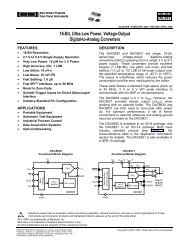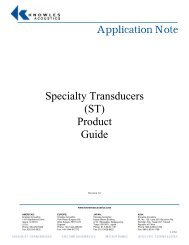AD7714* 3 V/5 V, CMOS, 500 µA Signal Conditioning ADC - dreamm
AD7714* 3 V/5 V, CMOS, 500 µA Signal Conditioning ADC - dreamm
AD7714* 3 V/5 V, CMOS, 500 µA Signal Conditioning ADC - dreamm
Create successful ePaper yourself
Turn your PDF publications into a flip-book with our unique Google optimized e-Paper software.
AD7714<br />
as P1.0) which is configured as an input. This port bit is then<br />
polled to determine the status of DRDY. The second scheme is<br />
to use an interrupt driven system in which case, the DRDY output<br />
is connected to the INT1 input of the 8XC51. For interfaces<br />
which require control of the CS input on the AD7714, one<br />
of the port bits of the 8XC51 (such as P1.1), which is configured<br />
as an output, can be used to drive the CS input.<br />
The 8XC51 is configured in its Mode 0 serial interface mode.<br />
Its serial interface contains a single data line. As a result, the<br />
DATA OUT and DATA IN pins of the AD7714 should be connected<br />
together. The serial clock on the 8XC51 idles high<br />
between data transfers and, therefore, the POL input of the<br />
AD7714 should be hard-wired to a logic high. The 8XC51 outputs<br />
the LSB first in a write operation while the AD7714<br />
expects the MSB first so the data to be transmitted has to be<br />
rearranged before being written to the output serial register.<br />
Similarly, the AD7714 outputs the MSB first during a read<br />
operation while the 8XC51 expects the LSB first. Therefore,<br />
the data which is read into the serial buffer needs to be rearranged<br />
before the correct data word from the AD7714 is available<br />
in the accumulator.<br />
DV DD<br />
SYNC<br />
RESET<br />
CODE FOR SETTING UP THE AD7714<br />
Table XV gives a set of read and write routines in C code for<br />
interfacing the 68HC11 microcontroller to the AD7714. The<br />
sample program sets up the various registers on the AD7714<br />
and reads 1000 samples from the part into the 68HC11. The<br />
setup conditions on the part are exactly the same as those outlined<br />
for the flowchart of Figure 8. In the example code given<br />
here the DRDY output is polled to determine if a new valid<br />
word is available in the output register.<br />
The sequence of the events in this program are as follows:<br />
1. Write to the Communications Register, setting the channel.<br />
2. Write to the Filter High Register, setting the 4 MSBs of the<br />
filter word and setting the part for 24-bit read, bipolar mode<br />
with boost off.<br />
3. Write to the Filter Low Register, setting the 8 LSBs of the<br />
filter word.<br />
4. Write to the Mode Register, setting the part for a gain of 1,<br />
burnout current off, no filter synchronization and initiating a<br />
self-calibration.<br />
5. Poll the DRDY Output.<br />
6. Read the data from the Data Register.<br />
7. Loop around doing steps 5 and 6 until the specified number<br />
of samples have been taken.<br />
RFS<br />
TFS<br />
ADSP-2103/2105<br />
DR<br />
CS<br />
DATA OUT<br />
AD7714<br />
DT<br />
DATA IN<br />
SCLK<br />
SCLK<br />
POL<br />
Figure 11. AD7714 to ADSP-2103/ADSP-2105 Interface<br />
AD7714 to ADSP-2103/ADSP-2105 Interface<br />
Figure 11 shows an interface between the AD7714 and the<br />
ADSP-2103/ADSP-2105 DSP processor. In the interface<br />
shown, the DRDY bit of the Communications Register is again<br />
monitored to determine when the Data Register is updated. The<br />
alternative scheme is to use an interrupt driven system in which<br />
case, the DRDY output is connected to the IRQ2 input of the<br />
ADSP-2103/ADSP-2105. The RFS and TFS pins of the<br />
ADSP-2103/ADSP-2105 are configured as active low outputs<br />
and the ADSP-2103/ADSP-2105 serial clock line, SCLK, is<br />
also configured as an output. The POL pin of the AD7714 is<br />
hard-wired low. Because the SCLK from the ADSP-2103/<br />
ADSP-2105 is a continuous clock, the CS of the AD7714 must<br />
be used to gate off the clock once the transfer is complete. The<br />
CS for the AD7714 is active when either the RFS or TFS outputs<br />
from the ADSP-2103/ADSP-2105 are active. The serial<br />
clock rate on the ADSP-2103/ADSP-2105 should be limited to<br />
3 MHz to ensure correct operation with the AD7714.<br />
–30–<br />
REV. B















